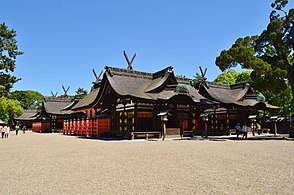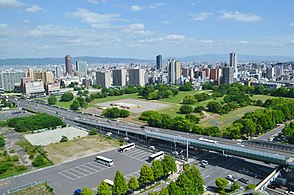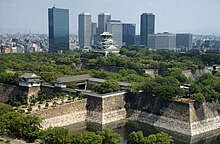
Kyoto, officially Kyoto City, is the capital city of Kyoto Prefecture in the Kansai region of Japan's largest and most populous island of Honshu. As of 2020, the city had a population of 1.46 million, making it the ninth-most populous city in Japan. More than half (56.8%) of Kyoto Prefecture's population resides in the city. The city is the cultural anchor of the substantially larger Greater Kyoto, a metropolitan statistical area (MSA) home to a census-estimated 3.8 million people. It is also part of the even larger Keihanshin metropolitan area, along with Osaka and Kobe.
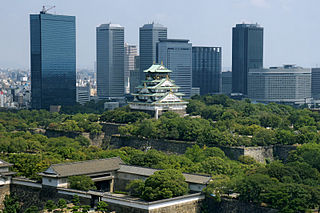
Osaka is a designated city in the Kansai region of Honshu in Japan, and one of the three major cities of Japan (Tokyo-Osaka-Nagoya). It is the capital of and most populous city in Osaka Prefecture, and the third-most populous city in Japan, following the special wards of Tokyo and Yokohama. With a population of 2.7 million in the 2020 census, it is also the largest component of the Keihanshin Metropolitan Area, which is the second-largest metropolitan area in Japan and the 10th-largest urban area in the world with more than 19 million inhabitants. Osaka, being the third most populous city in Japan, is considered the third safest city on Earth.
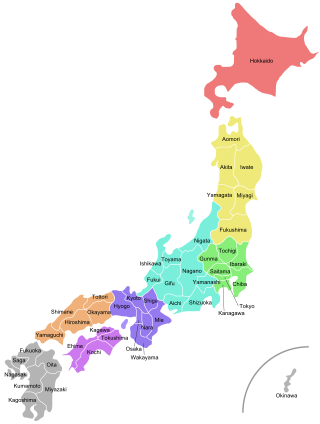
Japan is divided into 47 prefectures, which rank immediately below the national government and form the country's first level of jurisdiction and administrative division. They include 43 prefectures proper, two urban prefectures, one regional prefecture and one metropolis. In 1868, the Meiji Fuhanken sanchisei administration created the first prefectures to replace the urban and rural administrators in the parts of the country previously controlled directly by the shogunate and a few territories of rebels/shogunate loyalists who had not submitted to the new government such as Aizu/Wakamatsu. In 1871, all remaining feudal domains (han) were also transformed into prefectures, so that prefectures subdivided the whole country. In several waves of territorial consolidation, today's 47 prefectures were formed by the turn of the century. In many instances, these are contiguous with the ancient ritsuryō provinces of Japan.

Osaka Prefecture is a prefecture of Japan located in the Kansai region of Honshu. Osaka Prefecture has a population of 8,778,035 and has a geographic area of 1,905 square kilometres (736 sq mi). Osaka Prefecture borders Hyōgo Prefecture to the northwest, Kyoto Prefecture to the north, Nara Prefecture to the southeast, and Wakayama Prefecture to the south.

Tondabayashi is a city located in Osaka Prefecture, Japan. As of 31 January 2022, the city had an estimated population of 108,803, in 51,632 households and a population density of 1200 persons per km2. The total area of the city is 39.72 square kilometres (15.34 sq mi).

Nakae Chōmin was the pen-name of a journalist, political theorist and statesman in Meiji-period Japan. His real name was Nakae Tokusuke. His major contribution was the popularization of the egalitarian doctrines of the French philosopher Jean-Jacques Rousseau in Japan. As a result, Nakae is thought to have been a major force in the development of liberalism in early Japanese politics.

Tokyo City was a municipality in Japan and capital of Tokyo Prefecture which existed from 1 May 1889 until its merger with its prefecture on 1 July 1943. The historical boundaries of Tokyo City are now occupied by the special wards of Tokyo. The newly-merged government became what is now Tokyo, also known as the Tokyo Metropolis or, ambiguously, Tokyo Prefecture.
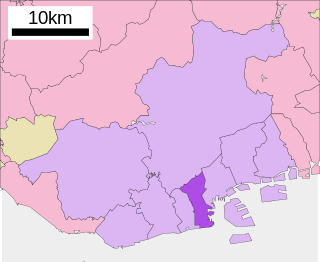
Hyogo is one of nine wards of Kobe, Japan. It has an area of 14.56 km2 and a population of 106,322.
The following is a timeline of the history of the city of Kyoto, Kyoto Prefecture, Honshu island, Japan.
The following is a timeline of the history of the city of Valencia, Spain.
The following is a timeline of the history of the city of São Paulo, Brazil.
The following is a timeline of the history of the city of Yokohama, Japan.
The following is a timeline of the history of the city of Nagasaki, Japan.
The following is a timeline of the history of the city of Kobe, Japan.
The following is a timeline of the history of the city of Nagoya, Japan.
The following is a timeline of the history of Fukuoka City, Japan.
The following is a timeline of the history of the city of Hiroshima, Japan.
The following is a timeline of the history of Tokyo, Japan.
The following is a timeline of the history of the city of Ljubljana, Slovenia.
The following is a timeline of the history of the city of Messina, Sicily, Italy.


